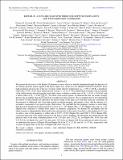Kepler-20: A sun-like star with three sub-neptune exoplanets and two earth-size candidates
Author(s)
Rogers, Leslie Anne; Seager, Sara
DownloadSeager_Kepler-20.pdf (3.046Mb)
PUBLISHER_POLICY
Publisher Policy
Article is made available in accordance with the publisher's policy and may be subject to US copyright law. Please refer to the publisher's site for terms of use.
Terms of use
Metadata
Show full item recordAbstract
We present the discovery of the Kepler-20 planetary system, which we initially identified through the detection of five distinct periodic transit signals in the Kepler light curve of the host star 2MASS J19104752+4220194. From high-resolution spectroscopy of the star, we find a stellar effective temperature T [subscript eff] = 5455 ± 100 K, a metallicity of [Fe/H] = 0.01 ± 0.04, and a surface gravity of log g = 4.4 ± 0.1. We combine these estimates with an estimate of the stellar density derived from the transit light curves to deduce a stellar mass of M ★ = 0.912 ± 0.034 M [subscript ☉] and a stellar radius of R ★ = 0.944[superscript+0.060] [subscript –0.095] R [subscript ☉]. For three of the transit signals, we demonstrate that our results strongly disfavor the possibility that these result from astrophysical false positives. We accomplish this by first identifying the subset of stellar blends that reproduce the precise shape of the light curve and then using the constraints on the presence of additional stars from high angular resolution imaging, photometric colors, and the absence of a secondary component in our spectroscopic observations. We conclude that the planetary scenario is more likely than that of an astrophysical false positive by a factor of 2 × 10[superscript 5] (Kepler-20b), 1 × 10[superscript 5] (Kepler-20c), and 1.1 × 10[superscript 3] (Kepler-20d), sufficient to validate these objects as planetary companions. For Kepler-20c and Kepler-20d, the blend scenario is independently disfavored by the achromaticity of the transit: from Spitzer data gathered at 4.5 μm, we infer a ratio of the planetary to stellar radii of 0.075 ± 0.015 (Kepler-20c) and 0.065 ± 0.011 (Kepler-20d), consistent with each of the depths measured in the Kepler optical bandpass. We determine the orbital periods and physical radii of the three confirmed planets to be 3.70 days and 1.91[superscript +0.12] [subscript –0.21] R [subscript ⊕] for Kepler-20b, 10.85 days and 3.07[superscript +0.20] [subscript –0.31] R [subscript ⊕] for Kepler-20c, and 77.61 days and 2.75[superscript +0.17] [subscript –0.30] R [subscript ⊕] for Kepler-20d. From multi-epoch radial velocities, we determine the masses of Kepler-20b and Kepler-20c to be 8.7 ± 2.2 M [subscript ⊕] and 16.1 ± 3.5 M [subscript ⊕], respectively, and we place an upper limit on the mass of Kepler-20d of 20.1 M [subscript ⊕] (2σ).
Date issued
2012-03Department
Massachusetts Institute of Technology. Department of Earth, Atmospheric, and Planetary Sciences; Massachusetts Institute of Technology. Department of PhysicsJournal
Astrophysical Journal
Publisher
IOP Publishing
Citation
Gautier, Thomas N. et al. “Kepler-20: A sun-like star with three sub-neptune exoplanets and two earth-size candidates.” The Astrophysical Journal 749.1 (2012): 15. © 2012 IOP Publishing
Version: Final published version
ISSN
0004-637X
1538-4357